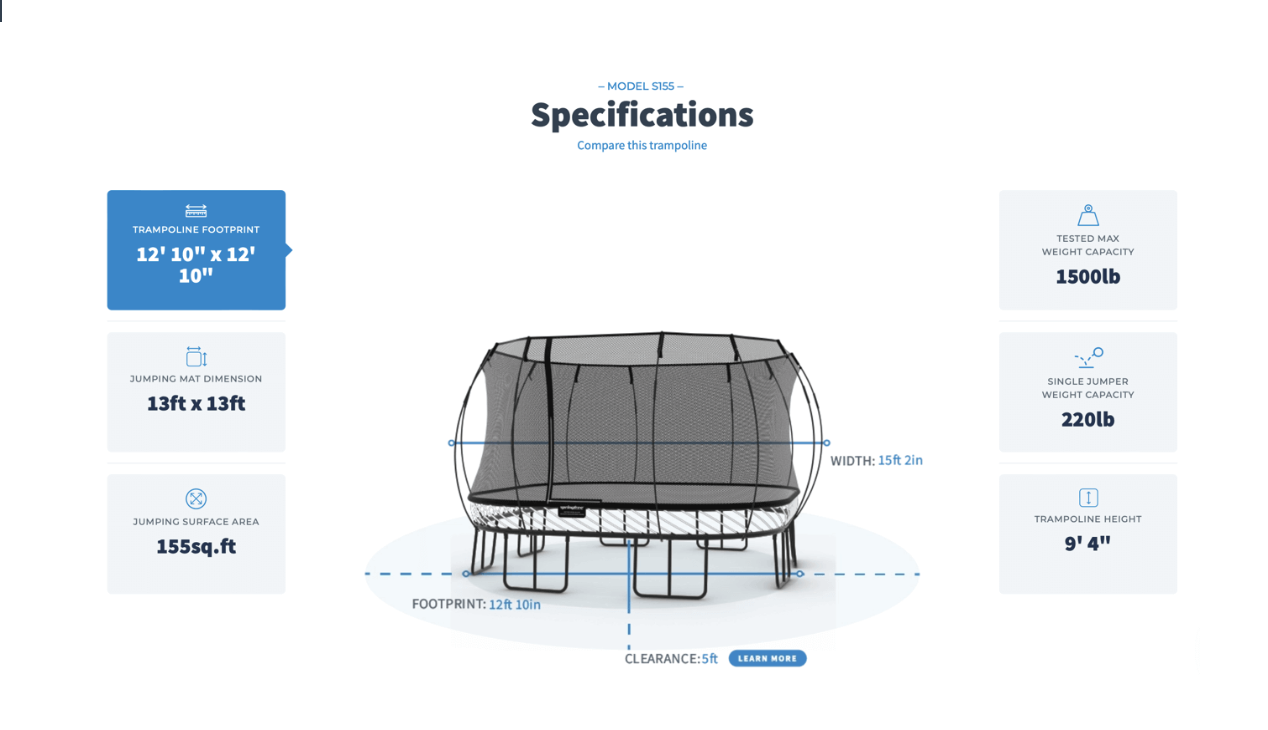We’re going to let you in on a little secret: The size of a trampoline is not always what it seems.
The amount of jumping space on a trampoline is a crucial factor to consider before buying a trampoline, especially if you have growing kids that want a trampoline to last throughout their childhood.
We’re going to use our years of expertise as a trampoline manufacturer to explain how the size of a trampoline differs from the amount of jumping space you have on a regular outdoor trampoline.
We’re also going to provide an example of how two similarly sized trampolines contrast on the amount of jumping space available.
After reading this, you will be well-equipped with the knowledge to make an informed decision on which size of trampoline you need for your family.
The Truth About Trampoline Sizes
So, what is the truth about trampoline sizes?
Well, let’s back up and first go over how trampoline manufacturers measure and publicise their trampoline sizes currently.
Trampolines are almost always measured frame-to-frame; that is the number you will see when you look for the dimensions of a trampoline. The graphic below, which is courtesy of JumpSport, gives you a visual of how frame-to-frame measurements look on a round trampoline:

That measurement is what manufacturers primarily use to state the size of their trampolines. But take a look at the graphic above and notice how the measurement extends to the white area around the mat.
The white area around the mat is where the springs lie. On a safer trampoline, the enclosure net will usually go between the mat and springs, although sometimes the springs are located inside the mat (a huge red flag for safety!).
Here’s what this traditional-style outdoor trampoline looks like, via The Krazy Coupon Lady:

The problem with this measuring precedent is it over-emphasises the amount of area you have to jump. You obviously cannot jump on the section of the trampoline where the springs lie, yet it is still a part of the total dimensions.
Because the springs can take up to around 2 ft of jumping space, this a problem for consumers that are trying to get a trampoline with plenty of jumping space.
Compounding this issue is that many manufacturers don’t even list the amount of jumping space available, leaving you to assume that you’re getting more jumping room than you have. This is where the misleading nature of trampoline sizes comes into play.
So, here’s the truth: Trampolines are measured frame-to-frame and published as such without talking about the amount of jumping space (in most cases). The problem with this? It can mislead you into buying a trampoline that you thought had more jumping space.
Now that you have this insider knowledge, let’s explain further how the size of a trampoline differs from the amount of jumping space:
Trampoline Sizes vs. Jumping Space
In the last section, we talked about how the frame-to-frame measurement of a trampoline is misleading in terms of the amount of space you have to jump.
That doesn’t mean those frame-to-frame dimensions are worthless, though. On the contrary, measuring frame-to-frame gives you the total dimensions of the trampoline, which is essential to know so you can make sure it fits into your yard.
The total size of the trampoline is also critical to know, and you should consider it when deciding which trampoline to purchase. You don’t want to buy a trampoline that doesn’t safely fit into your garden.
However, only using the frame-to-frame measurement as a basis for a purchasing decision is wrong in most cases: It overestimates how much jumping room you will have. And based on our internal analysis of other trampoline manufacturers, no other manufacturer of trampolines besides our Springfree models readily listed their jumping space.
Our Springfree Trampolines were the only ones to have the amount of jumping space listed. See below for an example (it’s listed under “Jumping Surface Area”):

A Final Word on Trampoline Sizes
We’ve gone over a lot of information, so let’s sum up the key points of this article:
- It has become standard across the trampoline industry to list the size of a trampoline as its frame-to-frame dimensions only.
- These dimensions, while important, are misleading in terms of the amount of jumping space you have---especially on traditional, spring trampolines.
- Manufacturers typically don’t make the amount of jumping space readily available, something that must change in order for you to make a fully informed decision on which size of trampoline you need.
If having plenty of jumping space is an important quality to have in your ideal trampoline, take the time to find out that information. Contact the manufacturer of the trampoline you’re interested in and ask how much jumping room is available on the model you’re looking at.
A good trampoline is not cheap, so make sure you evaluate your goals and don’t settle: A trampoline should be a staple of endless joy for your backyard and should never be a source of mass frustration!
What Size Trampoline Is Right for You?
Now that you know the truth behind trampoline sizes, which size should you go with?
Remember, the size of the trampoline is multi-faceted: Take into account the total dimensions and jumping space, while also considering the individual weight limit of the trampoline. Considering all of these factors will lead you to the right-sized trampoline for your goals.
With the Tool, you can follow three easy steps from your phone and place a trampoline, choosing from nine different sizes, into your backyard to see how it would look/fit at your house.
Reach out to us if you need assistance accessing the AR Tool or have any other questions about getting the right trampoline for you. We have a team of professionally trained experts that are ready and willing to help answer your most pressing questions!










